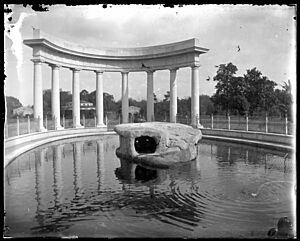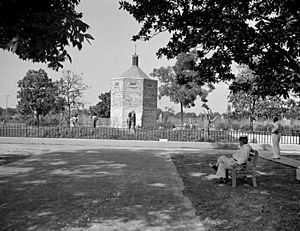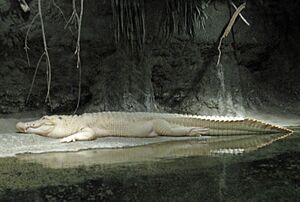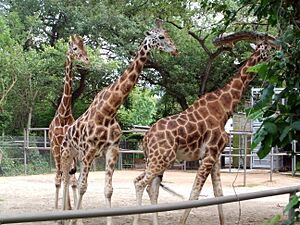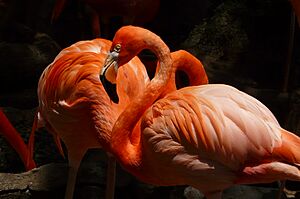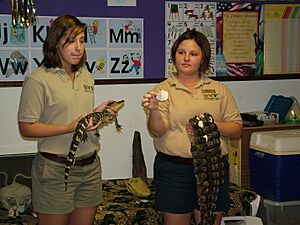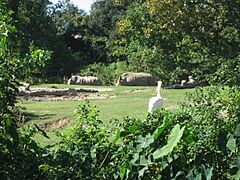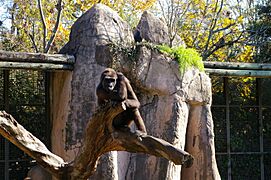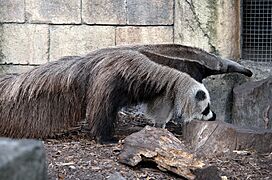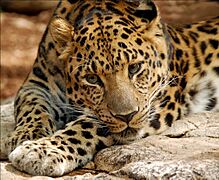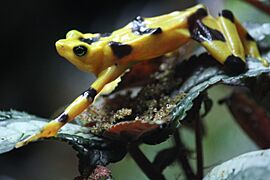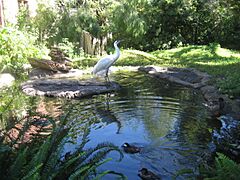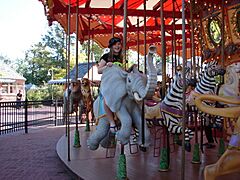Audubon Zoo facts for kids
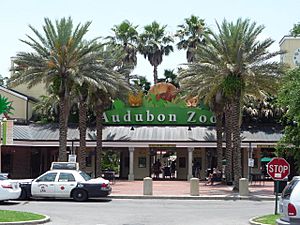
Main Entrance
|
|
| Date opened | 1914 |
|---|---|
| Location | New Orleans, Louisiana, United States |
| Land area | 58 acres (23 ha) |
| Coordinates | 29°55′23″N 90°07′56″W / 29.9231°N 90.1322°W |
| No. of animals | 2,000 |
| Memberships | AZA, WAZA |
| Major exhibits | African Savanna, Asian Domain, Audubon Aviary, Jaguar Jungle, Louisiana Swamp, Reptile Encounter, Sea Lion Theater, South American Pampas, World of Primates |
The Audubon Zoo is a famous zoo located in New Orleans, Louisiana, in the United States. It's a big place, covering 58 acres, and is home to more than 2,000 animals!
The zoo is part of the Audubon Nature Institute. This group also runs other cool places like the Audubon Aquarium and Audubon Park. The zoo and park are named after John James Audubon. He was a famous artist and naturalist who lived in New Orleans.
Contents
History of the Zoo
The land where the zoo sits has shown animals since 1884. That's when the World Cotton Centennial World's Fair happened there. The zoo we know today started growing in the early 1900s.
In 1916, a special cage for birds was added. During the 1920s, many new parts were built. This included a sea lion pool in 1928. You can still see this pool and some other old buildings today.
Building "Monkey Hill"
In the 1930s, during the Great Depression, the zoo got a big upgrade. Workers built many new animal cages. They also created a fun, artificial hill called "Monkey Hill."
New Orleans is a very flat city. So, Monkey Hill was built as a special attraction for children. Many local kids still love playing on it.
A New Beginning for the Zoo
By the early 1970s, the zoo was not in good shape. The old cages were small and not good for the animals. A study suggested the zoo might need to close.
But the city and its people wanted to save it. In 1975, voters approved money to rebuild the zoo. The zoo grew from 14 acres to 50 acres. By the end of the 1970s, Audubon Zoo was becoming one of the best zoos in the United States.
More improvements kept happening into the 2000s. This made the zoo very popular with both locals and tourists.
Special White Alligators
In 1987, something amazing happened. A nest of American alligators was found with 18 white babies! This is a very rare natural change called leucism. It's different from albinism.
These white alligators became very famous. They even became a symbol of the zoo. Some of them later moved to the Audubon Aquarium.
Hurricane Katrina and Recovery
In 2005, Hurricane Katrina hit New Orleans. The zoo staff stayed safe in the reptile house. This building was made to handle big storms. It was on high ground, so it did not flood.
Most of the animals survived the storm. Only three animals died. The main damage was fallen trees. The zoo faced challenges getting food and supplies after the storm.
The zoo reopened in November 2005 for Thanksgiving weekend. It first opened only on weekends due to money issues. By March 2006, it was open Wednesday through Sunday. Later, it expanded to Tuesday through Sunday.
Jaguar Escape Incident
On July 14, 2018, a jaguar named Valerio escaped from its home. It got out through the roof of its enclosure. The incident happened before the zoo opened to visitors. Sadly, the jaguar killed six other animals and injured three more before it was safely caught again.
Notable Attractions
Near the zoo's entrance, you can see beautiful American flamingos and whooping cranes.
Asian Domain
This area is home to animals from Asia. You can see Sumatran orangutans and Asian elephants. The elephants have large yards with pools.
Other animals here include Amur leopards, sun bears, Asian small-clawed otters, Malayan tigers, and barasingha deer.
World of Primates
This section has many different types of primates. You can see groups of western lowland gorillas and mandrills.
Other primates include black-and-white colobus monkeys, Wolf's guenons, black howler monkeys, and golden lion tamarins.
African Savanna
Before entering the Savanna, visit the Watoto Walk petting zoo. Here you can meet donkeys, miniature zebu, goats, and sheep.
In the Savanna, you'll see tall giraffes, black crowned cranes, and marabou storks. There are also homes for African wild dogs and lions. You can also spot white rhinos, Burchell's zebras, and blue wildebeest.
South American Pampas
At the start of this area, you'll find the maned wolfs. Walk across a boardwalk over a large pond. Here, you'll see bright Caribbean flamingos and American white pelicans.
Along the boardwalk, there's a big yard for capybaras, greater rheas, and Patagonian maras. Another yard has Baird's tapirs and guanacos.
Jaguar Jungle
This area looks like old Mayan ruins. It's home to jaguars, giant anteaters, ocelots, and Geoffroy's spider monkeys. You can also see alpacas, scarlet macaws, and blue-and-yellow macaws.
A new night-time exhibit called "Criaturas de la Noche" opened in 2019. It features animals active at night. These include Seba's short-tailed bats, Nancy Ma's night monkeys, and different kinds of frogs and insects.
Audubon Aviary
This is a special walk-through bird house. More than 30 types of birds from all over the world fly freely here. You might see blue-crowned laughingthrushes, Indian peafowl, and scarlet ibises. Outside the aviary, there is a yard for emus.
Louisiana Swamp
This outdoor exhibit shows animals native to southern Louisiana. You can see American black bears, cougars, bobcats, and North American river otters.
It also has many types of fish, snakes, and alligator snapping turtles. Of course, there are many American alligators, including the rare white ones.
Reptile Encounter
This exhibit is home to many different reptiles and amphibians. One of the most famous residents is the Komodo dragon.
You can also see the colorful panther chameleon, the Gila monster, and the huge green anaconda.
Sea Lion Theater
California sea lions live in a large lagoon here. Two female sea lions, Ayah and Jolee, arrived at the zoo in 2017. They were rescued after being found stranded. Ayah had a bullet in her brain, causing her to lose an eye.
Gallery
-
Rhinoceros exhibit


